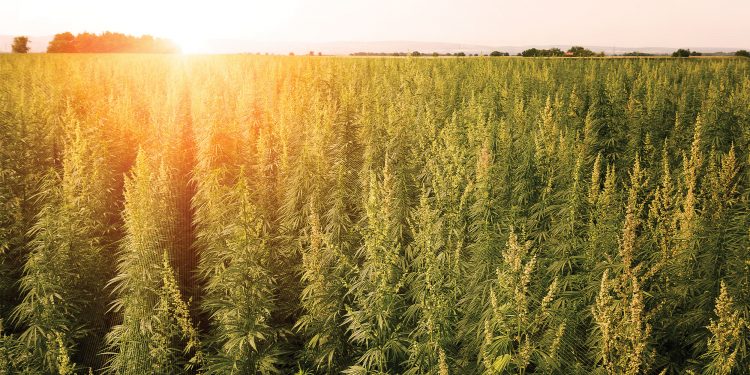Now that hemp is legal to grow, Kentucky has a new cash crop with seemingly unlimited potential — if the approved farmers can figure out how to harvest a healthy crop.
The 2018 Farm Bill removed industrial hemp from the federal Controlled Substances Act. As soon as President Trump signed the bill in December of 2018, Kentucky Agriculture Commissioner Ryan Quarles submitted Kentucky’s hemp plan to the U.S. Agriculture Secretary, making Kentucky the first state to file its plan.
210 growers were licensed to plant up to 16,100 acres of industrial hemp in the Bluegrass in 2018. This year, the approved acreage jumped to 42,000.
Ag Commissioner Quarles claims the growth in the number of approved acres from 16,000 last year to 42,000 this year shows that Kentucky is rapidly becoming the epicenter of the hemp industry in the United States.
Three Owensboro residents are on the front end of this new wave of opportunity in Kentucky agriculture. Robbie Clark owns the farmland that his grandfather started farming 80 years ago in Ohio County. His friend, Chris Templeton, has an agriculture background in turf management, previously working at a golf course and currently for an ag business using plant technology to help local farmers fight plant diseases and produce better yields. Robbie and Chris also have a silent partner with the entrepreneurial spirit to round out their partnership. So together, the three friends decided to try this new endeavor and formed Kentucky Green Hemp, LLC.
Clark says it was a lengthy and in-depth process to get their permit to grow. But since they were approved in January, things have moved quickly. They received their license in March, and plan to plant their first hemp rows in late May, although April rain showers have delayed their plans just a bit.
“It just so happens that Kentucky’s humid climate is perfect for this crop, which makes a lot of sense, because it’s the same reason tobacco grows so well here,” Clark said. Other farmers they’ve talked to say it takes 90-110 days for the crop to grow. After harvest, it will hang in the barn to dry for a few weeks. Then Kentucky Green Hemp can sell to a processor.
There are actually three licenses industrial hemp growers can apply for. One is for the floral part of the plant, or the bud, which is the part of the plant used to make CBD oil. The second license is for the fiber, or stock of the plant, which is used for clothing, rope, plastic, and wood substitute products. The third license is for cultivating seeds to grow more plants. Kentucky Green Hemp applied for the floral license.
“We’re all proponents of CBD because of the health benefits,” Clark explains. “Each one of us has so many friends and family taking opioid type medications that can lead to addictions so easily. CBD helps with so many things: inflammation, pain relief, cancer, arthritis, anxiety, and epilepsy. I like the idea that this can help a lot of people, and it’s a great opportunity for us to be on the front end of this growth. That’s what’s exciting about it — everybody is new at this. We’re all learning as we go. We talk to other farmers and processors all the time, and we learn from each other. The way I see it, if we all succeed, the sky is the limit!”
“What I like about it,” Templeton says, “is being able to see where our stuff (what we grow) goes. Not only are we helping people and making a quality product, but we can determine the end product ourselves, and we know how it will be used by the consumer. And the potential is … well, there’s nothing else like it. Can you think of another crop you can sell three different ways?”
Chris says he debated on doing something with hemp for several years before partnering with Robbie and their silent partner. “My older brother lives in San Francisco, and is a huge proponent of hemp. He’s been telling me for years about the uses for hemp and what the plant can do for agriculture.”
CBD oil has exploded in popularity the past few years, leading some people to fear the market is already flooded, but Templeton says he’s not concerned. “If you do the math on the acres allowed in Kentucky divided by the allotted number of farmers, it’s less than 40 acres of hemp per grower.”
Robbie and Chris might make this all sound adventurous, but if it seems a little risky, that’s because it is. For starters, no one knows for sure yet what the market price will be for this first harvest. There’s no insurance for it, which means if the crop fails, the growers have no way to recoup their losses. In addition to the threat of mold, which is also a serious concern, the crop — if it survives and is able to be harvested — will be highly regulated.
The Kentucky Department of Agriculture will test for THC levels two weeks before harvest. After harvest, the processor will also test the crop for pesticides and herbicides because CBD oil is a consumable. “The processor pays based on CBD percentage and poundage. So it’s to our advantage to grow a quality crop, but we’re just learning as we go this first time,” Templeton explained.
He added, “I like the fact that it’s a free market. We determine our selling price. But at the same time, the buyers are going to choose the best product. So the guys who are growing the best product will be the ones who will be able to keep this going.”










